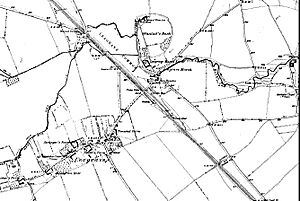Waulud's Bank facts for kids
| Location | Leagrave, Luton |
|---|---|
| Region | Bedfordshire, England |
| Coordinates | 51°54′37″N 0°27′30″W / 51.91028°N 0.45833°W |
| Type | Domestic enclosure or Henge |
| History | |
| Periods | Neolithic |
| Site notes | |
| Condition | ruin |
Waulud's Bank is an ancient site in Leagrave, Luton. It might be a henge, which is a special type of circular earthwork. This place dates back to around 3,000 BC. That's a very long time ago, in the Neolithic period, also known as the New Stone Age.
Discovering Waulud's Bank
Waulud's Bank is in the northern part of Luton. It sits near Leagrave Common. The River Lea flows right next to it on the western side. The river starts very close by, in the surrounding marshy area.
Scientists have dug at Waulud's Bank several times. They did this in 1953, 1971, and 1982. These digs showed that the site is about 5,000 years old. People lived here during the Neolithic period. There was also proof of even older activity. People who hunted and fished lived here during the Mesolithic period (Middle Stone Age).
The earthwork at Waulud's Bank is shaped like a "D". This is very similar to another ancient site called Marden in Wiltshire. Both sites have a river forming one side of their shape. Both also had special pottery from the Neolithic period. Waulud's Bank is on a ridge formed by ancient ice. A very old path called the Icknield Way runs nearby.
Scientists think Waulud's Bank was first used to keep cattle. It was like a big pen for animals. Later, it might have become a henge monument. However, the ditch around it is outside the bank, which is unusual for a henge. The site was also used again for short times. This happened during the Iron Age, when the Romans were in Britain, and in medieval times.
What Waulud's Bank Looks Like
The ancient area is about 7 hectares in size. It has a bank and a ditch outside it. The bank was made from chalk and gravel. It was covered with grass and had a wooden fence, or stockade, on top. No clear entrances have been found.
Sadly, some parts of Waulud's Bank have been damaged. A gravel quarry in the 1800s destroyed features on the south side. In the 1970s, during the building of Marsh Farm, a lot of chalk and soil was dumped on the eastern side. This also caused damage.
Scientists used special equipment in 1985 and 2009. They tried to find hidden features inside the bank. But they didn't find much.
Today, the bank is still quite tall in some places. It stands about 2.6 meters high. On the north side, the ditch was dug out. It was 9.2 meters wide and 2.1 meters deep.
When they dug at the site, they found interesting things. They found Neolithic pottery and animal bones. They also found flint arrowheads. Some of these items are now on display at the Stockwood Heritage Centre,Luton Museum.
The building next to Waulud's Bank used to be a farmhouse. It was called Marsh Farm House. The people who lived there owned the land that later became Marsh Farm.
Myths and Legends
The River Lea starts at a place called the 'Five-Springs'. This spot is in the north-west corner of Waulud's Bank. Old stories say that a Celtic god named Lug (also called Lud or Lyg) was linked to these springs.
Lug was a Celtic god of light. The name 'Lea' for the river might come from his name. The town of Luton is named after this river. So, Luton could mean "the town on the river of Lugus." This is just a guess, though. 'Ton' is an Anglo-Saxon word for a town or settlement.
The English Heritage organization has records about Waulud's Bank. They suggest that 'Waulud' might be a changed version of the name Wayland. Wayland was a famous smith in Norse stories. He was also known as Wolund, Weyland, or Weland. You can learn more about him at Wayland's Smithy.
Some old writers thought Waulud's Bank was a place called Lygeanburgh. A similar-sounding place, Limbury, is nearby. Limbury means a strong place on the River Lea. Lygeanburgh was one of four settlements mentioned in an old book called the Anglo-Saxon Chronicle. A prince named Cuthwulf captured these places in 571. Lygeanburgh and Limbury were probably the same place. But so far, no digs have directly linked them to Waulud's Bank.
There are also rumors about a large Roman villa. People thought it was on Bramingham Road, which is next to Waulud's Bank. But there is no proof for these rumors. The site is close to where the ancient Icknield Way crossed the River Lea. It's also about 5 kilometers from Watling Street in Dunstable. Watling Street is another road with Roman history.


